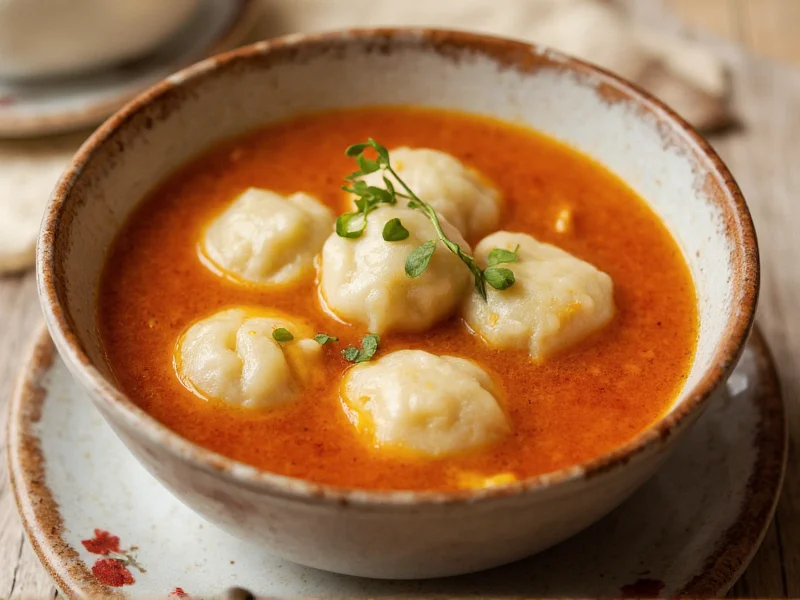Potato dumpling soup represents one of Europe's most cherished comfort foods, with roots stretching across Poland, Germany, and the Czech Republic. This humble dish transforms simple pantry staples into a satisfying meal that has sustained families through harsh winters for generations. Unlike many modern recipes that compromise on authenticity, traditional potato dumpling soup maintains its integrity through careful preparation and respect for technique.
The Cultural Significance of Potato Dumpling Soup
Known as kluski ziemniaczane in Poland, Kartoffelklöße in Germany, and bramboráky in the Czech Republic, this dish emerged during the 18th century when potatoes became widely available across Central Europe. Potato dumpling soup evolved as a practical solution for using surplus potatoes while creating a substantial meal. Each region developed distinctive variations—Polish versions often include marjoram and bacon, German preparations feature nutmeg, while Czech renditions sometimes incorporate fried onions.
Essential Ingredients for Authentic Flavor
The magic of potato dumpling soup lies in its simplicity. High-quality ingredients make the difference between ordinary and extraordinary results. Select starchy potatoes like Russets or Yukon Golds for optimal dumpling texture. Freshly ground black pepper and优质肉汤 (quality broth) elevate the basic components into something remarkable. Many home cooks make the mistake of using waxy potatoes, which contain too much moisture and cause dumplings to disintegrate during cooking.
| Ingredient | Traditional Amount | Key Purpose |
|---|---|---|
| Russet potatoes | 2 lbs (900g) | Provides starch foundation for dumplings |
| All-purpose flour | 1 cup (125g) | Binds ingredients without overpowering |
| Egg | 1 large | Creates cohesive dumpling structure |
| Onion | 1 medium | Adds aromatic depth to broth |
| Chicken or vegetable broth | 6 cups (1.4L) | Forms flavorful soup base |
Step-by-Step Preparation Guide
Creating perfect potato dumpling soup requires attention to technique. Start by boiling potatoes with skins intact to preserve moisture content. While still warm, press through a ricer or food mill—never use a food processor which releases too much starch. Mix with flour, egg, and salt until just combined; overmixing creates tough dumplings. For the broth, sauté onions until golden before adding broth and bringing to a gentle simmer.
Form dumplings by rolling tablespoon portions between slightly damp palms. Carefully drop into simmering broth and cook for 8-10 minutes until they float to the surface. Remove with a slotted spoon to prevent overcooking. The broth should remain at a gentle simmer throughout cooking—boiling vigorously will break apart the delicate dumplings.
Regional Variations Worth Exploring
Traditional Polish potato dumpling soup often includes fried bacon and marjoram, while German versions incorporate nutmeg and sometimes caraway seeds. Czech preparations frequently feature fried onions as a topping. In colder regions, cooks sometimes add sauerkraut for tanginess and preservation benefits. For a contemporary twist, some chefs incorporate roasted garlic or fresh herbs like dill into the dumpling mixture itself.
Perfect Pairings and Serving Techniques
Serve potato dumpling soup immediately while dumplings remain tender. Traditional accompaniments include dark rye bread and a dollop of sour cream. The soup's richness balances beautifully with crisp green salads dressed in vinegar-based dressings. For special occasions, many families garnish with fresh chives and a sprinkle of paprika. Remember that dumplings continue cooking slightly after removal from broth, so slightly undercooking ensures perfect texture when served.
Troubleshooting Common Issues
Dumplings falling apart usually indicates excess moisture in the potato mixture—ensure thorough pressing and consider adding a bit more flour. Dense dumplings typically result from overmixing or using cold potatoes. If broth becomes cloudy, clarify by adding beaten egg white and gently simmering before straining. For optimal results, prepare dumplings immediately after making the potato mixture, as resting causes them to become gummy.
Storage and Reheating Recommendations
Store potato dumpling soup components separately for best results. Keep broth refrigerated for up to 4 days while storing dumplings in a single layer with parchment paper between them. Reheat broth gently before adding dumplings for 2-3 minutes. Freezing dumplings works well when placed on a baking sheet first, then transferred to freezer bags. Never freeze dumplings in broth as they become waterlogged upon thawing.
Frequently Asked Questions
Can I make potato dumpling soup gluten-free?
Yes, substitute the all-purpose flour with a 1:1 gluten-free flour blend containing xanthan gum. Potato starch works well as an alternative thickener. Ensure your broth is certified gluten-free, as many commercial varieties contain wheat derivatives.
Why do my potato dumplings keep falling apart in the soup?
This typically happens when potatoes contain too much moisture. Always press cooked potatoes through a ricer while hot, and let them cool slightly to evaporate excess steam. Adding a small amount of additional flour (1-2 tablespoons) usually solves this problem without compromising texture.
How can I prevent my potato dumplings from becoming dense?
Dense dumplings usually result from overmixing the dough or using cold potatoes. Handle the mixture gently just until combined, and work with potatoes while they're still warm. Avoid pressing or kneading the dumpling mixture, as this develops gluten and creates toughness.
What's the best way to store leftover potato dumpling soup?
Store components separately: broth in one container, dumplings in another with a light coating of oil to prevent sticking. Refrigerate for up to 3 days. When reheating, warm the broth first, then add dumplings for 2-3 minutes. Never store dumplings in broth as they'll absorb too much liquid and become soggy.
Can I prepare potato dumplings ahead of time?
Absolutely. Form dumplings and place them on a floured baking sheet, then freeze until solid. Transfer to freezer bags and store for up to 2 months. Cook directly from frozen, adding 1-2 minutes to cooking time. This make-ahead technique works perfectly for meal preparation.











 浙公网安备
33010002000092号
浙公网安备
33010002000092号 浙B2-20120091-4
浙B2-20120091-4